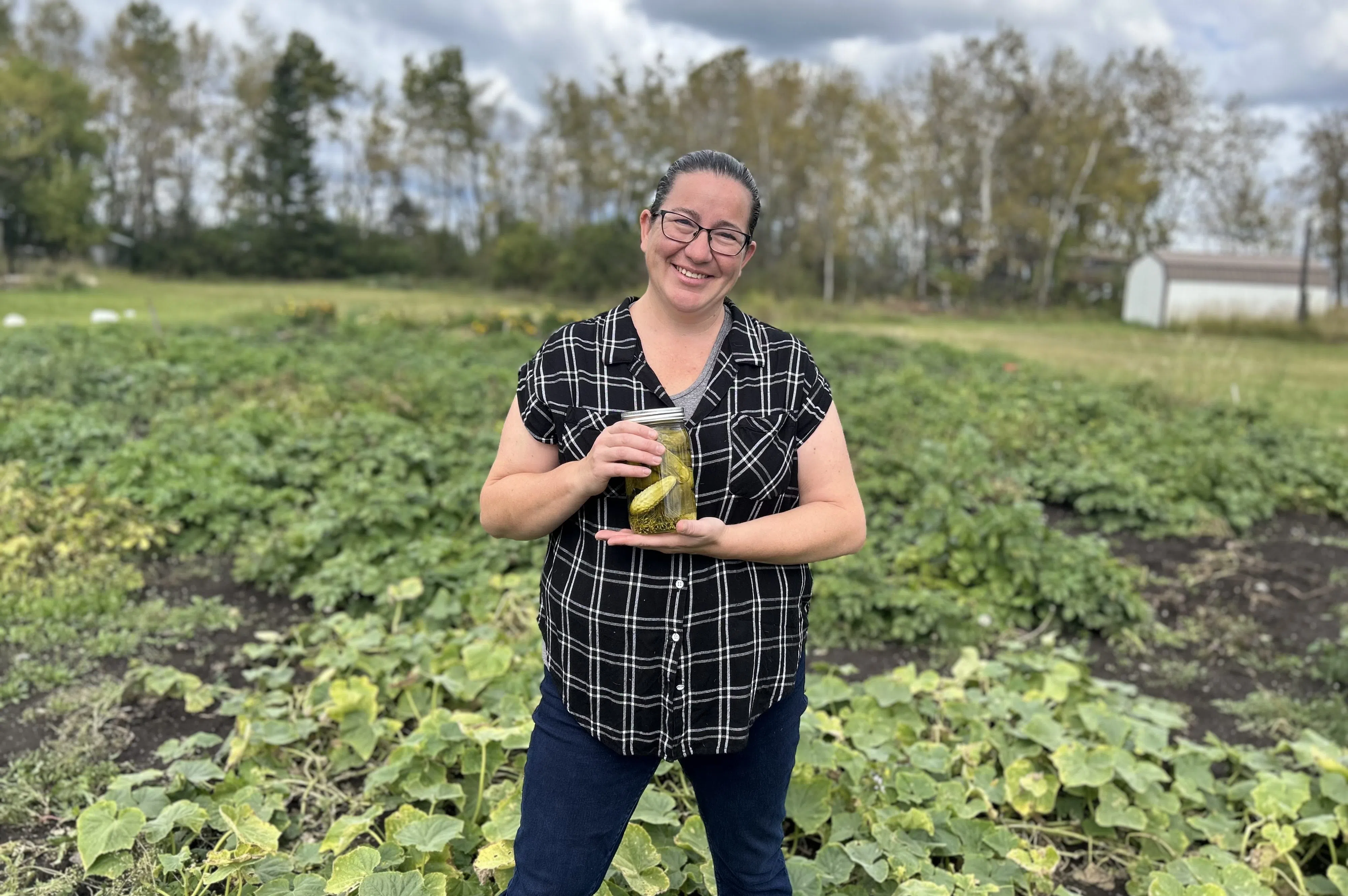
Preserving Traditions: The Art and Heart of Family Pickling
As the chill of autumn settles in, there’s a particular magic that envelops the garden at Timberland, Sask. Here, Anita Smith can be found diligently harvesting the last of her cucumbers, ensuring not a single fruit is left behind before frost threatens. This annual ritual is not just about gathering produce; it’s a heartfelt reflection on the legacy of preservation that has been lovingly passed down through generations.
“I guess I began really when I started washing jars for my mom when I was a little girl,” she reminisces, her hands quickly maneuvering through the prickly vines. “I would tell her, ‘Ugh, I’m never gonna do this when I’m older.’ Now I wash more jars than my mom ever made me do—by choice!”
Anita’s garden is expansive, filled with a bounty of fruits and vegetables, all destined for the jars that line her pantry shelf. Each year, she preserves hundreds of pounds of her harvest, a testimony to the time-honored practices her family has maintained.
“I do green beans and carrots and corn the old-fashioned way, with glass lids and rubber rings in a water bath on top of the stove,” she proudly states. “Not too many people do it anymore.” Her commitment to traditional methods highlights a growing movement among those who cherish the process of canning—not merely as a means to an end but as an art intertwining community, family, and memory.
 Anita Smith harvesting cucumbers on a brisk autumn day.
Anita Smith harvesting cucumbers on a brisk autumn day.
Smith’s canning repertoire is as diverse as the garden itself. From jams and jellies to relishes and mustard beans, she showcases an array of recipes that tell a story. Yet, the crown jewel of her collection remains her grandmother’s dill pickles.
“She would use only larger cucumbers for her dill pickles,” Smith explains, “but my mom included the little ones too. We’d fight over the baby pickle!” Each precious bite is laden with family lore, offering more than just flavor but a taste of nostalgia.
Her father played a pivotal role in passing down this cherished tradition. Without a recipe of her own, Anita’s mother turned to her husband, who ensured the generations before them were not forgotten. “My mom didn’t have a pickle recipe, so my dad took her to see his mom and get her recipe,” she reflects, her eyes twinkling with warmth as she shares the tale.
“My grandma only spoke French, so my mom couldn’t really communicate with her. My dad had to translate the recipe into English. So, good on Dad for getting it right!”
 Anita Smith’s family’s treasured dill pickle recipe, bridging cultures and generations.
Anita Smith’s family’s treasured dill pickle recipe, bridging cultures and generations.
While each family member has contributed their unique touch to these recipes, competition over the coveted baby pickle became a pleasant memory. “It was always a fight to who got the baby pickles. They were the best,” she chuckles, reminiscing about how her siblings devised ways to keep jars of only baby pickles. This was their solution to ease the struggle for that delightful morsel, a humorous side note in their family traditions.
As a mother of two, Anita is committed to ensuring that this beloved recipe endures. “I’ve already taught my daughters how to can, so I know that this recipe will be passed on not only to my daughters but maybe their children,” she beams, proud of the legacies she’s nurturing within her own family.
Reflecting on the fragility of these traditions, Smith shares a poignant thought: “I read this one thing that said it only takes two generations to lose family traditions. Once you skip a generation, it’s very easy for the next generation to skip it too. Then before you know it, it’s lost.” The weight of preserving not just techniques but the memories tied to them feels increasingly heavy in today’s fast-paced world.
Despite the labor-intensive nature of canning, Smith finds profound satisfaction in every jar sealed. “It’s so worth it. The only part that should disappear is the last baby pickle!” she affirms, demonstrating a love for both preserving food and family stories, channeling the essence of her heritage and the delicious results.
In preserving their history through pickling, Anita Smith and others like her embody a vital connection to their past while simultaneously crafting a future where traditions are not just remembered but actively experienced. As the golden leaves fall and the frost creeps in, the warmth of her kitchen—and the jars of pickles stored within—remain a testament to the power of food in sustaining family bonds.
Embracing the Craft: The Modern Revival of Pickling
As Anita reflects on her experiences, it becomes clear that the artistry of pickling is experiencing a renaissance. In an age where convenience often trumps tradition, a growing number of individuals are rediscovering the joys and benefits of canning. From community workshops to online tutorials, the knowledge once exclusive to family kitchens is now being shared widely, often sparking a newfound enthusiasm for home canning.
This modern movement isn’t incidental; it is rooted in a desire for quality control. Many are concerned about the preservatives and additives found in mass-produced food products. By preserving their own produce, they not only engage with their food on a deeper level but also ensure that they are consuming what they truly want—simple ingredients, organically grown.
“It’s amazing how much control you have over your food when you make it yourself. It really puts you in touch with what you’re eating,” shares Marie Foley, a local canning enthusiast. “It creates a sense of accomplishment, too.”
As communities forge bonds over this shared experience, pickling has become a metaphor for connection—not only to one another but to the land itself. Taking to their gardens, many are choosing to cultivate their own ingredients, resulting in greater awareness of where food comes from and the environment that sustains it. Today, picklers are not just canning; they are reviving a form of culinary heritage that speaks volumes about sustainability and the nurturing of relationships.
 Brightly colored jars of pickles lined up, each one a unique story in itself.
Brightly colored jars of pickles lined up, each one a unique story in itself.
In the future, as younger generations engage with the craft, the essence of traditions like Anita’s dill pickles will continue to flourish, ensuring that the art of pickling does not just survive but thrives. Amidst the rush of today’s world, these moments spent with family, preserving the harvest, are moments that cultivate love, memory, and identity. In every jar lies the promise of continuity—a forever savoring of the past amidst the ever-flowing stream of time.
In the gentle cadence of seasonal changes and in every pickle, the cadence of history can be tasted—for the generations to come know that in preserving traditions, they hold a rich narrative of who they are.
Conclusion
To truly appreciate food is to understand its story, its roots, and, importantly, its connections. As everyone from established canners to eager newcomers begins their pickling journey, it’s undeniable that every batch passed around—every jar uncapped—is an embodiment of the love, tradition, and flavors that bind them together. Whether it’s a family recipe or a spontaneous creation, the art of pickling remains a vibrant celebration of life’s harvests.
Let the jars fill, let the pickles crunch, and let the stories flow—this is the legacy of pickling, preserved through the ages.











